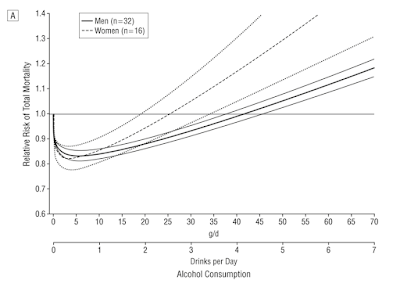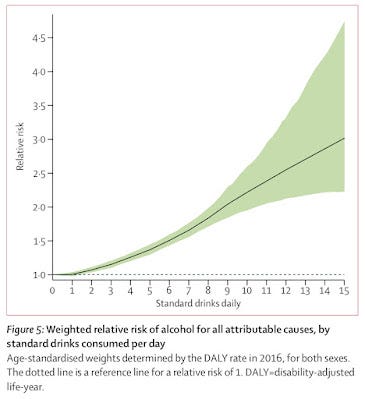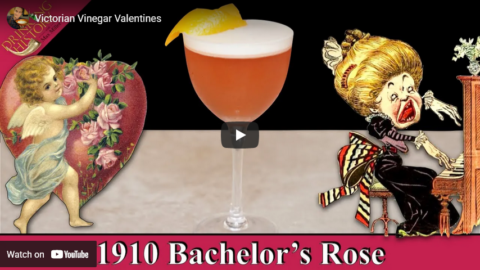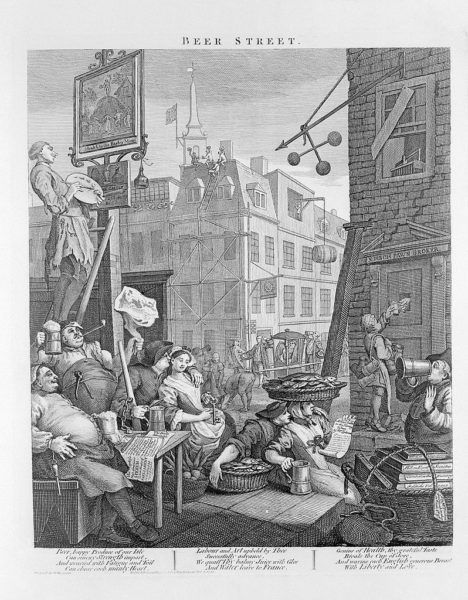English Heritage
Published 7 Dec 2016Mr Lincoln, the butler, is very busy with Christmas preparations, so Mrs Crocombe is making some Christmas gin punch for the servants in the kitchens of Audley End House.
INGREDIENTS
250g Brown Sugar
7 lemons
750ml Gin
750ml Ginger Wine
250g Honey
A Pinch of Cloves
1 tsp Cinnamon
1 tsp Nutmeg
Hot WaterMETHOD
In a large bowl, add the sugar, nutmeg, cinnamon, cloves, lemons, honey, gin and ginger wine. Add some hot water to your taste and give everything a good stir. You can then decant your punch into a decorative bowl and serve.
(more…)
December 26, 2022
How to Make Christmas Gin Punch – The Victorian Way
December 25, 2022
What the heck is Wassail?
Tasting History with Max Miller
Published 16 Dec 2022
(more…)
December 23, 2022
Hot Buttered Rum – Food Wishes
Food Wishes
Published 8 Dec 2020You can do a lot of great things with rum. Make rum balls, soak a chocolate cake, pour it into a glass of cola, and of course, entertain pirates, but maybe my favorite thing to do with rum, especially around the holidays, would be to butter it. Enjoy!
(more…)
December 20, 2022
Eggnog: A Christmas History
Tasting History with Max Miller
Published 22 Dec 2020
(more…)
October 29, 2022
The Absinthe Murder
Tasting History with Max Miller
Published 28 Jun 2022
(more…)
September 14, 2022
Whisky – Scotland’s Water of Life
Tasting History with Max Miller
Published 13 Sep 2022
September 6, 2022
Add the traditional English pub to the endangered list
There is nothing to match the warm, cozy comfort of a proper English pub*, especially on those cold, wet days as evening falls. Traditional pubs have been struggling for some time as British preferences in entertainment, drinking, and dining have become more cosmopolitan over the years. The raw numbers of pubs has declined year-over-year for decades, but it’s looking like the winter of 2022/23 may be the worst time for pubs in living memory:
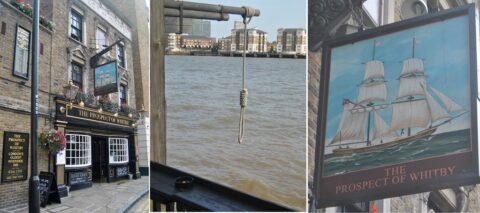
“The Prospect of Whitby ; Pub London” by Loco Steve is licensed under CC BY-SA 2.0 .
Simon Pegg’s wise counsel in Shaun of the Dead – “Go to the Winchester, have a nice, cold pint, and wait for all this to blow over” – has long been shared in GIF form whenever a new crisis springs into view.
Chillingly, this time next year, that may no longer be an option. To the Great British pub, the winter energy crisis represents an existential threat. And on the back of two years drifting in purgatory under lockdown, many pubs are facing a war of extermination.
The trade publication for pubs, the Morning Advertiser, makes for especially grim reading at the moment. Its pages are dominated by the energy crisis. It suggests that without urgent government intervention, more than 70 per cent of existing licensed premises will not survive the winter.
One “wet-led” pub – that is, a pub-pub (one that relies on the sale of alcohol to remain viable, rather than on burger stacks and artisan chips served on a slate hubcap) – illustrates this plight all too clearly. Until this summer, it had been paying 14p per electricity unit on a fixed energy contract. But it has now been quoted 83p a unit. It is hard to imagine any cost that could rise so vertically without dealing a mortal blow to a business balanced on the edge of viability. And it’s not as if heating and energy are optional extras during the winter. This is not a thriller, this is a snuff movie.
Pubs have always faced challenges, of course, going right back to the Civil War and the mirthless interregnum. Thanks to Cromwell’s war on harmless pastimes – such as bear-baiting, whoring and dice – you will rarely see him honoured on pub signs in the way you see a Royal Oak or a King’s Arms.
The First World War famously saw the introduction of last orders. This was to keep munitions workers working. It was one of those temporary, emergency measures that, like income tax, proved oddly barbed once in the flesh of the state. As the 20th century wore on, rationing and oil shocks tightened belts. And then, under Thatcher, the rise of restaurants, wine bars and other sub-pub drinking options diffused the economic benefit of those re-loosened belts.
Drink-driving legislation and smoking bans delivered a slow-motion one-two that left many well-established premises, especially in rural locations, reeling. And in the background, the steady drip-drip of anti-drinking propaganda from bodies such as Public Health England (now rebranded as the Health Security Agency) has done its damage, too. The public-health lobby sees drinking only in terms of abuse, while ignoring the social benefits, the knitting-together, the public mental health of England that the public house affords.
* The Scots and the Welsh may have issues with this, but based on my experiences of drinking and dining in pubs in all three countries, it’s the English pub by a country mile. Welsh pubs can be pleasant, but Scottish pubs outside Edinburgh remind me of grim old Ontario bars back when Ontario was still just emerging from the post-Prohibition no-fun-on-Sunday Orange Lodge era (“We’ll let you drink, but you must be made to feel guilty for it!”).
September 1, 2022
QotD: The origins of the Bloody Mary
“Yes, yes please dear boy. You can prepare me a small rhesus negative Bloody Mary. And you must tell me all the news. I haven’t seen you since you finished your last film.” Uncle Monty, the lubricious booby in Bruce Robinson’s wonderful Withnail & I, selects his pre-prandial from a drinks table pregnant with possibilities with all the care one would expect from a seasoned practitioner. And so he might. For a Bloody Mary is perfect at almost any time of day and in every kind of weather.
All the best bars serve Bloody Marys. But the best Bloody Mary is served in The Grenadier, the one-time officers’ mess of the Foot Guards and the long-time public house in Wilton Row, Belgravia. Pass beneath the low lintel of this tiny tavern, pick your way through the crowded tap room and press up against the burr mahogany bar to order the world’s premier pick-me-up.
[…]
The Grenadier is rightly proud of its reputation for restorative remedies and particularly this one. Into the glass go vodka, and a sizeable slug (preferably Stolichnaya), a stirrup of sherry (the secret weapon), tomato juice, then spices (Tabasco and Worcestershire sauce), citron (lemon or lime) and salt to personal taste. The addition of a celery stick is entirely superfluous but for those in search of their hair of the dog, a little light salad I suppose is a help — of sorts.
Yet this pub, though an historic watering hole, cannot claim to be the home of the Mary. That right is retained across the Channel in Paris by Harry’s New York Bar. There exactly a century ago in the City of Light, Fernand Petiot, perfected his “bucket of blood”. The name was soon changed to something a little less Madame la Guillotine and the Mary as we know it was born.
Christopher Pincher, “Hail Mary”, The Critic, 2022-05-30.
July 17, 2022
Science by press release
Christopher Snowden on a media-genic “study” from a few years ago that supported the priors of the anti-alcohol campaigners and thus was given full uncritical media coverage, despite obvious flaws in data selection and methodology:
In 2018, the Lancet published a study from the “Global Burden of Disease Alcohol Collaborators” which claimed that there was no safe level of alcohol consumption. This was widely reported and was naturally welcomed by anti-alcohol campaigners. The BBC reported it under the headline “No alcohol safe to drink, global study confirms”. (Note the cheeky use of the word confirms, despite the finding going against fifty years of evidence.)
The study wasn’t based on any new epidemiology. Instead it took crude, aggregate data from almost every country in the world, mashed it together and attempted to come up with a global risk curve.
The study contains no new evidence and uses an unusual modelling approach based on population-wide data from various online sources. If you look at this massive appendix you can see the kind of data they were using. The figures are extremely crude.
The authors don’t dispute the benefits of moderate drinking for heart disease but they claim that the benefits are matched by risks from other diseases at low levels of consumption and are outweighed by the risks at higher levels of consumption. Some diseases which have been associated with benefits of drinking, such as dementia, are excluded from the analysis entirely. They also ignore overall mortality, which you might think was kind of important.
A typical risk curve for alcohol consumption and mortality is J-shaped. It looks like this …
But the GBD’s risk curve for “all attributable causes” looked like this…
You will notice that there appears to be no protective effect at moderate rates of consumption in the GBD’s curve. One important reason for this is that they associate alcohol consumption at any level with tuberculosis. Tuberculosis remains a serious health problem in much of the world, but not in Britain. So what relevance does a global risk curve have to us? None.
Moreover, TB is not really an alcohol-related disease and is only viewed as such in this study because (a) drinking might weaken the immune system and (b) people who go to bars and clubs are more likely to catch an infectious disease. I kid you not.
June 12, 2022
QotD: Zima
There was, however, something perversely enticing about a drink that seemed to come from a post-apocalyptic wasteland in which color did not exist. There was an ingrained assumption that Zima must be expressly targeted at somebody, but nobody knew who that was … Zima was ridiculous … but did that actually mean it was brilliant? The only viable conclusion was “sort of”.
It’s true at first blush, but so douchey that you want it to be wrong just to spite whoever wrote it. I’ve never wanted a Zima more in my life than I did after reading that passage. But at second glance, it’s laughably false. Ask anyone who was in college in the 1990s; they’ll tell you exactly who Zima was “expressly targeted at”: Frat bros who were expecting female company. Because it was clear — no, really, it was beer(-ish) that looked like club soda — it somehow seemed like “diet beer”. Which meant your female party guests were almost guaranteed to have three or four more than they should.
In other words: Zima was the midrange panty dropper. Not as classy as white zinfandel, not as trashy as Boone’s Farm, there was no other possible reason to have it in your dorm fridge, but it somehow had plausible deniability when you offered it to her as a light refreshment. If Klosterman ever had sex at any time between January 1, 1990 and December 31, 1999, he knows this. There’s no way he doesn’t.
Severian, “A Meta-Review”, Founding Questions, 2022-02-24.
February 12, 2022
Victorian Vinegar Valentines
Tasting History with Max Miller
Published 11 Feb 2022Hayman Sloe Gin: https://bit.ly/maxbottlescollection
Support the Channel with Patreon ► https://www.patreon.com/tastinghistory
Merch ► crowdmade.com/collections/tastinghistory
Instagram ► https://www.instagram.com/tastinghist…
Twitter ► https://twitter.com/TastingHistory1
Tiktok ► TastingHistory
Reddit ► r/TastingHistory
Discord ► https://discord.gg/d7nbEpy
Amazon Wish List ► https://amzn.to/3i0mwGtSend mail to:
Tasting History
PO Box 766
Burbank, CA 91503LINKS TO INGREDIENTS & EQUIPMENT**
Sony Alpha 7C Camera: https://amzn.to/2MQbNTK
Sigma 24-70mm f/2.8 Lens: https://amzn.to/35tjyoW
Home Oak Bar: https://amzn.to/37QGNdE
Industrial Pipe Liquor Shelves: https://amzn.to/37OR61S
Monin Raspberry Syrup: https://amzn.to/3HqFW3v
Nick & Nora Crystal Martini Glass: https://amzn.to/3L9zuzWRecipe
Bachelor’s Rose
Juice of a half a lemon
Juice of half a lime
Juice of half orange
White of an egg
25% raspberry syrup
75% Sloe gin
Fill glass with cracked ice.
Shake well, strain and serve.
1910 Jack’s Manual by J A Grohusko (Jacob Abraham)**Some of the links and other products that appear on this video are from companies which Tasting History will earn an affiliate commission or referral bonus. Each purchase made from these links will help to support this channel with no additional cost to you. The content in this video is accurate as of the posting date. Some of the offers mentioned may no longer be available.
Subtitles: Jose Mendoza | IG @ worldagainstjose
PHOTO CREDITS
Sloe berries: CC BY-SA 3.0, https://commons.wikimedia.org/w/index…#tastinghistory #valentinesday
February 1, 2022
QotD: Intoxication
Intoxicated? The word did not express it by a mile. He was oiled, boiled, fried, plastered, whiffled, sozzled, and blotto.
P.G. Wodehouse, Meet Mr. Mulliner, 1927.
January 1, 2022
Merry Olde England
Sebastian Milbank on the often disparaged nostalgic view of “the good times of old England”:
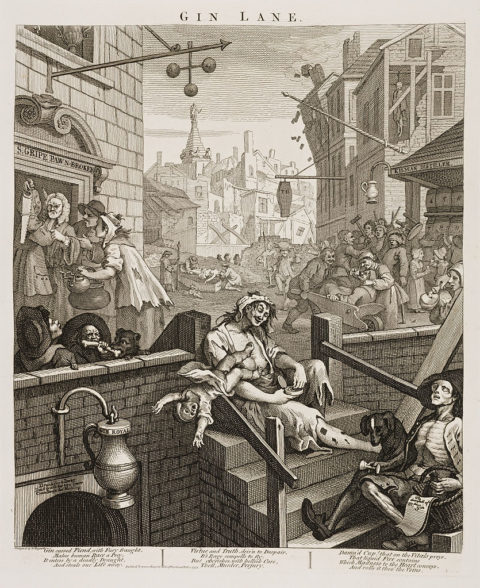
Gin Lane, from Beer Street and Gin Lane. A scene of urban desolation with gin-crazed Londoners, notably a woman who lets her child fall to its death and an emaciated ballad-seller; in the background is the tower of St George’s Bloomsbury.
The accompanying poem, printed on the bottom, reads:
Gin, cursed Fiend, with Fury fraught,
Makes human Race a Prey.
It enters by a deadly Draught
And steals our Life away.
Virtue and Truth, driv’n to Despair
Its Rage compells to fly,
But cherishes with hellish Care
Theft, Murder, Perjury.
Damned Cup! that on the Vitals preys
That liquid Fire contains,
Which Madness to the heart conveys,
And rolls it thro’ the Veins.
Wikimedia Commons.
The decadence and excess of the city is of a piece with puritanical restraint
William Wordsworth wrote:
They called Thee Merry England, in old time;
A happy people won for thee that name
With envy heard in many a distant clime;
And, spite of change, for me thou keep’st the same
Endearing title, a responsive chime
To the heart’s fond belief; though some there are
Whose sterner judgments deem that word a snare
For inattentive Fancy, like the lime
Which foolish birds are caught with. Can, I ask,
This face of rural beauty be a mask
For discontent, and poverty, and crime;
These spreading towns a cloak for lawless will?
Forbid it, Heaven! and Merry England still
Shall be thy rightful name, in prose and rhyme!Merry England is an easily mocked concept in today’s society, but in my view it carries a perennial insight: that the decadence and excess of the city is of a piece with puritanical restraint. Both apparently opposite features reflect an urban sophistication and the ruling imperative of commerce. The moneymaking frenzy of cities like London gave rise to excessive consumption and the relaxing of prior moral and social norms. Yet the 17th century Puritans were in large part cityfolk, alienated from rural tradition and well represented amongst bankers, merchants and urban middle class trades and professions.
William Hogarth’s most famous engraving is Gin Lane, which shows a street filled with people immiserated by the gin craze, a child toppling out of its mother’s arms, emaciated figures dying in the open, madmen dancing with corpses, a pawn-shop with the grandeur of a bank eagerly sucking in objects of domestic industry and converting them into gin money. Less well known is the image that accompanied it, the engraving Beer Street. In this latter engraving, plump and prosperous individuals pause from their labour to receive huge foaming mugs of ale, buxom housemaids flirt with cheerful tipplers, bright inn signs are painted, buildings are going up, and the pawn-shop is going out of business.
Merry England is an image of a society centred on human life and happiness rather than the demands of commerce. Here labour and rest both have their place: noble objects like a fine building and a bounteous meal are provided by hard work, but once completed, time is devoted to appreciating and relishing the finished product. Decoration and adornment are the outward sign of this; they are by their nature a form of abundance. The finite object of labour and production thus gives rise to an infinite realm of feast, celebration, adornment and signification. This enchanted public sphere, shaped to the human person, is limitless within its limits, and points beyond itself to the truly limitless and eternal world of the transcendent.
In the commercially determined sphere of modernity, it is instead work and consumption that are rendered limitless. The objects have become entirely ones of consumption — there is no limit to the consumption of gin, which stands in for all consumer objects. Hogarth shows us the humane objects of household industry — the good cooking pots, the tongs, the saw and the kettle — replaced with money. Liquidity is everywhere, capital has broken down the social order, removing all distinctions of sex, age and class. Now all persons and all things are joined together by a single seamless system of predation.
The alternative that many advocated to this situation was embodied in the Temperance movement: a Puritan-dominated enterprise which saw drinking as a threat to industry as well as the spiritual and moral health of the nation. This is a deep tendency in the British character: the impulse to look upon poverty and distress as a culpable disease and to preach individual self-restraint as the cure. Puritans were often well-to-do, literate townspeople, whose collective refusal to participate in dancing, drama, drinking, gambling, racing and boxing not only set them apart from the boisterous lower orders, but also from the quaffing, hunting, hawking and whoring nobility.
December 30, 2021
HogmaNO! Scottish government warns Scots not to cross the border to celebrate Hogmanay
In Scotland, one of the traditions of the winter is Hogmanay (spelled umpteen different ways), the last day of the old year, but Scottish public health and government officials are trying to keep the Scots away from the English border this year:
Scots have been urged not to travel to England for new year celebrations to get around the more stringent Covid-19 restrictions north of the border.
There is no travel ban currently in place to stop people going to England, where nightclubs are still open.
But Deputy First Minister John Swinney said doing so would go against the “spirit” of Scottish Covid-19 measures.
He said travelling would be “the wrong course of action” due to the “serious situation” with the Omicron variant.
Case numbers in Scotland hit “alarming” record highs over Christmas and Boxing Day, with the faster-spreading strain now accounting for the majority of all infections.
First Minister Nicola Sturgeon — who is to update MSPs in a virtual sitting of the Scottish Parliament on Wednesday afternoon — said she expected the figures to rise even more in the days ahead.
Scots have been encouraged to stay at home as much as possible, and to limit any social gatherings to no more than three households.
Large events such as Edinburgh’s traditional Hogmanay street party have been cancelled, with extra curbs in hospitality settings and nightclubs shut down entirely.
Clubs remain open south of the border, where no new restrictions are being imposed, but Mr Swinney told BBC Breakfast that he would “discourage” anyone from travelling to England to see in the new year.
He said: “People are free to make their own judgments. But what we have got recognise is that Omicron is a serious threat to absolutely everybody within our society and we have all got to take measures to protect ourselves by limiting our social contacts and connections and by complying with the restrictions we have in place.
Despite the Scottish government’s warnings, English pubs along the (currently) undefended border are expecting over a hundred thousand thirsty Scots to invade on the 31st:
English border pubs are expecting upwards of 100,000 Scottish and Welsh revellers to cross into England on New Year’s Eve amid mounting anger at Nicola Sturgeon and Mark Drakeford for cracking down on festivities.
December 11, 2021
QotD: In praise of getting stinkin’ drunk
A lot of this has come to mind because I’ve been reading an interesting new book — Drunk: How We Sipped, Danced, and Stumbled Our Way to Civilization by Edward Slingerland. Using history, science, myth and popular culture, Slingerland defends getting drunk. Drinking has always played a role in “enhancing creativity, alleviating stress, building trust, and pulling off the miracle of getting fiercely tribal primates to cooperate with strangers.” There is archaeological evidence that brewing precedes baking.
Slingerland admits the problem of problem drinking. Yet he convincingly argues that the downside of booze has been addressed at length over the last 30 or 40 years. It’s time, he observes, for some pushback against the “puritanical discomfort with pleasure lurking in the background of scholarly discourse.” Slingerland decries “our current age of neo-prohibition and general queasiness about risk,” and exports “the simple joy of feeling good.”
Slingerland, a philosopher at the University of British Columbia in Canada, then goes even further, positing that by causing humans “to become, at least temporarily, more creative, cultural, and communal … intoxicants provided the spark that allowed us to form truly large-scale groups.”
That is to say, without Budweiser and red wine, civilization might not have been possible. For our ancestors, intoxication was “a robust and elegant response to the challenges of getting a selfish, suspicious, narrowly goal-oriented primate to loosen up and connect with strangers.” Brewing vats and drinking vessels were found at a 12,000-year-old site in Turkey. When humans began to sow crops and domesticate livestock, it allowed us to get over distrust and work in larger numbers, giving rise to towns and then cities. Slingerland: “It is no accident that, in the brutal competition of cultural groups from which civilizations emerged, it is the drinkers, smokers and trippers who emerged triumphant.”
Mark Judge, “Drunk: The Vital Pleasure of Getting Hammered”, SpliceToday, 2021-09-01.

